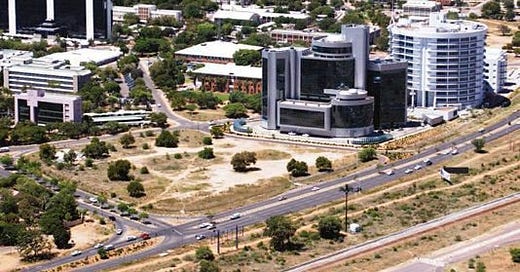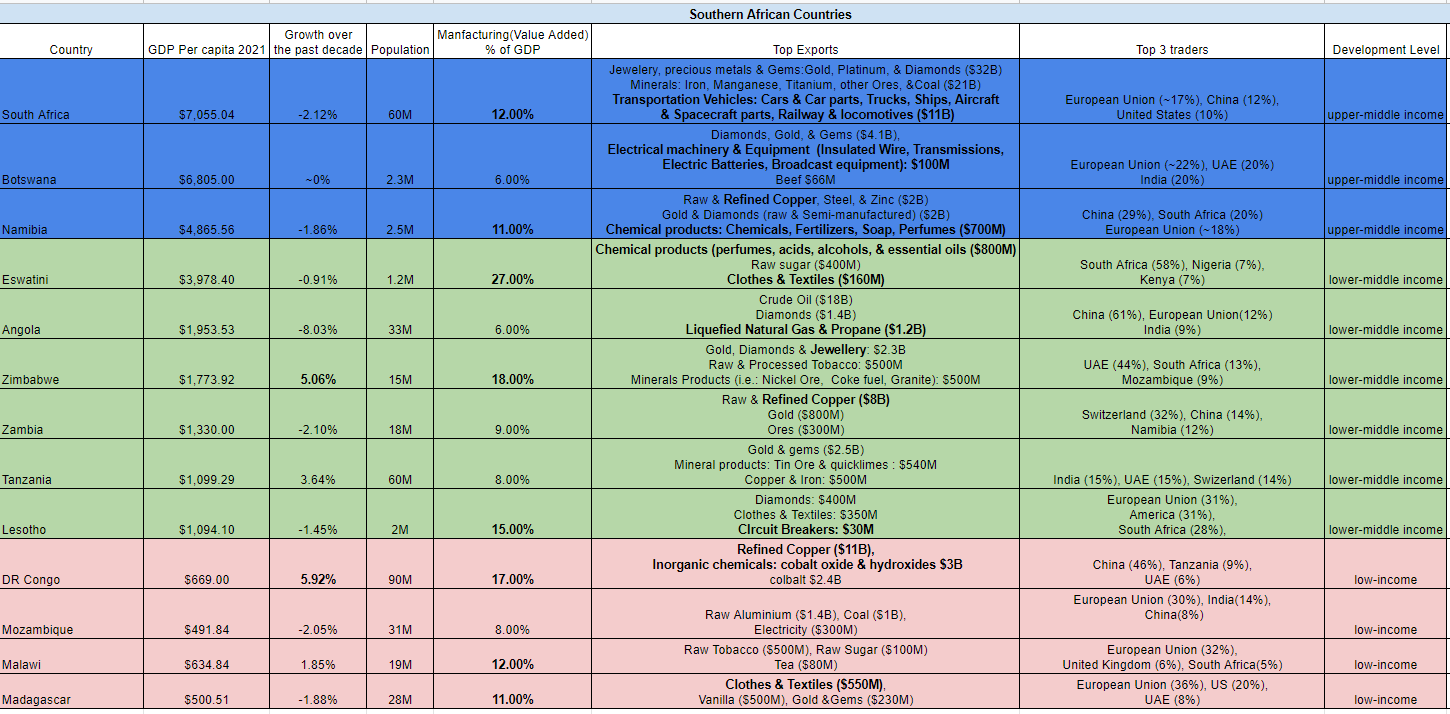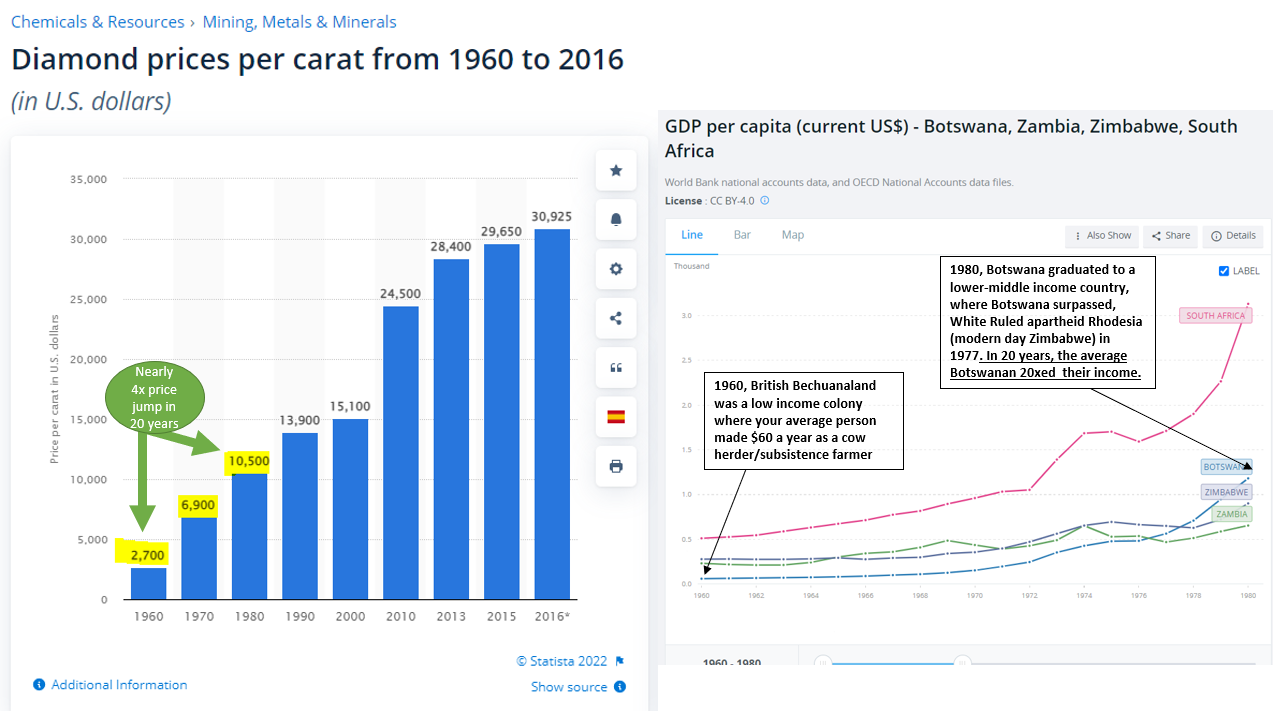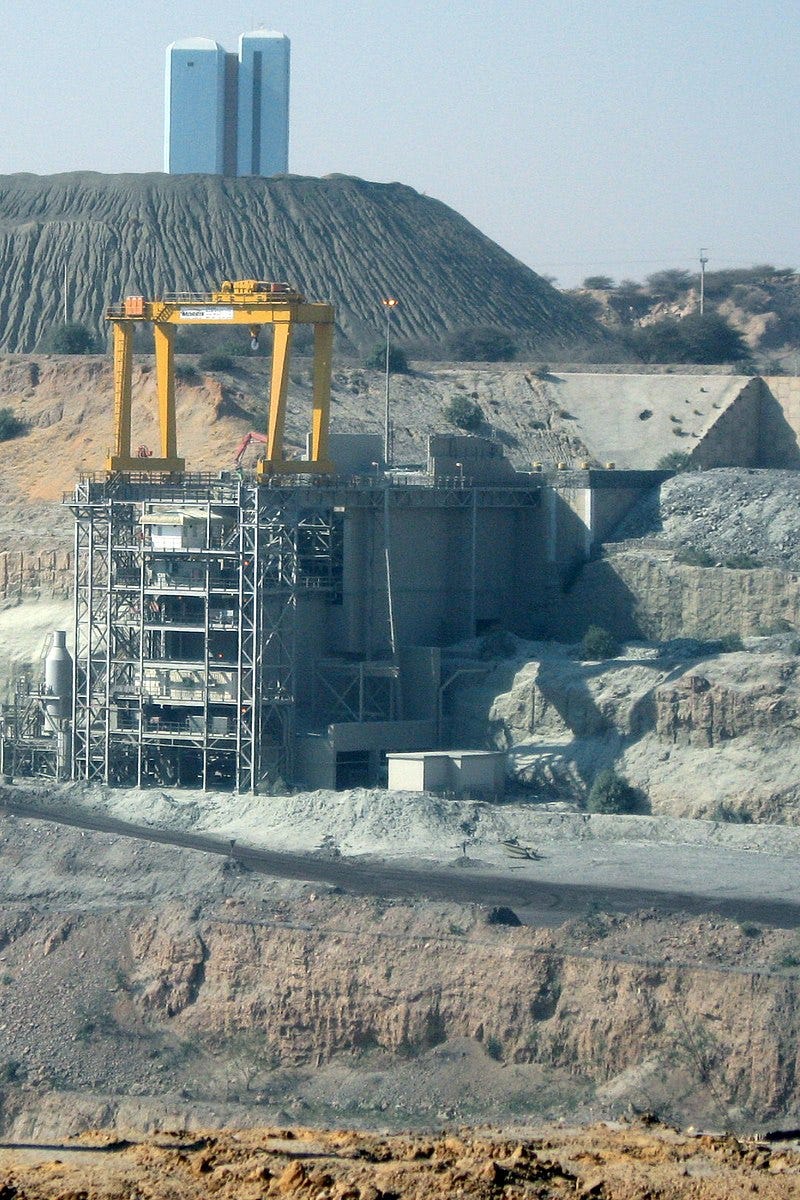Think for a moment. Can you name one Sub-Saharan African country (besides South Africa) that’s richer than a European nation?
Most people can’t answer this.
The reality is “people from Botswana are richer, on average, than people from Albania, Moldova, Armenia, Kosovo, or Ukraine (even before Russia invaded it in 2014 or 2022).”
Last time on Africa, we spoke about Cote d’Ivoire, a lower-middle income country. Today we are going to talk about a landlocked, upper-middle income country in Africa, Botswana. Botswana is very dry, 70% of Botswana is in the Kalahari dessert. This harsh environment only allows a small population, despite the country being the same size as France or Texas. It is has the strongest rated democracy on the continent: 7.73 out of 10, which is higher than Italy or Greece. It is one of the few African nations where investing in their bonds is investment grade debt instead of speculative debt/junk debt. It has negligible government debt and doesn’t depend on foreign aid. Botswana has a sovereign wealth fund with over $4B in assets, making it the 4th largest sovereign wealth fund in Africa. Botswana has 2.5M people, around the same population of Gambia. A singular Botswana person is a “Motswana” and plural is “Batswana”.
Botswana received independence somewhat late in 1966. When it was a British Protectorate it was called “Bechuanaland” which means “land of the Tswana tribe”. It only has 11 ethnic groups, but you can roughly split the population as: 73% Bantu Tswana, 18% Bantu Kalanga, 2% non-Bantu San people (the short, indigenous Southern Africans before Bantu invasion 600 AD), and 7% other (Indian, South African, White). By African standards, it’s basically a homogenous country.
Despite it’s economic growth, Botswana has many issues. Botswana has the 3rd highest HIV/AIDS rate on earth. Also, according to the Paris School of Economics’ World Inequality report, Botswana has the 9th highest income & wealth inequality of any nation on Earth: the top 10% of Botswana make ~60% of the national income and hold ~80% of the wealth. (South Africa is the worst on earth for income & wealth inequality with the top 10% producing 65% of income & owning 86% of wealth, for USA, the top 10% make 46% of income & own 70% of wealth, making America an unequal outlier for advanced nations). Botswana’s inequality is mainly due to the fact that most of the income growth has been mainly in the diamond mining & government sectors. The service sector is comprised of poorly paid service jobs, and manufacturing is extremely small in Botswana.
Botswana’s Economic Ranking
When the World Bank & IMF - two UN Agencies that collect data on human development & provide loan assistance to struggling countries - rank countries, they put them into 4 buckets: low income (i.e. Democratic Republic of Congo, Yemen, Afghanistan), lower-middle income (i.e. Nigeria, The Philippines, India), upper-middle income (South Africa, Botswana, Brazil, Mexico), or upper-income (America, Germany, Qatar). I’m going to compare these countries to China on a graph just to show you the differences of countries. China is on the verge of becoming a high-income country by the end of this year (2022) or2023.

Despite Botswana being upper-middle income like South Africa. South Africa is significantly more industrialized and diversified in its exports, while Botswana is primarily a diamond mining economy.

Pre-Colonization
Because Bechuanaland didn’t produce any diamonds during British rule, it was one of UK’s worst possessions. In fact, Bechuanaland were largely left to self rule. It was perceived by the British to be a scarcely populated, resource-scarce, desert, populated with 500K, mainly impoverished & illiterate, farmers, hunters, and cattle ranchers. The only reason Britain took it was to prevent the Dutch Boers or Germans from taking the territory. If UK discovered diamonds before independent Botswana did… I might be writing an entirely different history). In the 1800s, before the Berlin conference, Tswana chieftaincy Kingdoms in the south were fighting wars with the Dutch Boers.

Cattle Development: Prior to independence, the British and Seretse Khama, the Prime Minister of Bechuanaland (Pre-Independence name of Botswana), made a National Development Bank to provide cheap loans to cattle farmers and nationalized slaughterhouses by making the government the sole buyer of meat. The state would pay cattle ranchers more when the international beef prices went down, and pay them a little less during the good times.
Founding Fathers: President 1: Seretse Khama (1966-1980) & President 2: Quett Masire (1980-1998)
Botswana had colonial administrators who helped the native Batswana until the British felt that they could govern themselves (hence why independence was a tad later by 1966. 23 African countries got independence between 1950-1960).
Seretse had his work cut out for him. At independence with a population of 500K, Botswana was the 10th poorest country on Earth (average person made $90 in a year). The average Motswana was only $5 richer than the average Haitian and it only had with (7.5 mi) 12km paved roads. It had 22 university graduates & 100 high school graduates and the vast majority of people were subsistence farmers or cattle herders. Unlike other African countries that quickly went to authoritarian, one party rule like Ivory Coast’s (Felix Houphounet Boigny), Botswana maintained a multiparty democracy with checks and balances to prevent corruption. One important aspect is that Botswana’s political institutions didn’t erupt out of thin air. It wasn’t hard for Botswana to maintain democracy since during their British protectorate status, their institutions were not British made but rather the people were largely self ruled by their chieftaincy government, kgotla, a proto-multi party democratic system.
Economic wise, Seretse was super open to Western multinational firm investment of mineral resources.
Seretse was focused on using Western firms, like the British De Beers, look for raw materials in Botswana. Eventually, after one year after independence, Western firms discovered coal, copper, nickel, but most importantly diamonds in Orapa. Instead of nationalizing the diamond industry, Seretse set up a equity and profit sharing deal with De Beers to set up the firm Debswana, a joint venture firm between Botswana & De Beers that mined Botswana’s diamonds. Unfortunately, the Botswana government and De Beers would forcefully relocate the indigenous San people to housing settlements in order to mine diamonds on their land. The San people were pushed into poverty just for resource extraction.

Initially the Botswanan government owned 15% of Debswana, while DeBeers owned 85%. But over the next five years, Seretse used Debswana’s profits so the Botswanan government could end up owning 50% of Debswana. Diamonds, unlike other commodities like cocoa or oil have consistently increased price every decade. This is mainly because DeBeers was a cartel monopoly that owned 85% on the global diamond market from 1888 to early 2000s. DeBeers literally controlled supply & demand of diamonds by price fixing (AKA De Beers would horde diamond inventory or stop diamond digging to restrict diamond supply to keep price high). As a result, Botswana has never had a commodity bust issue that led to balance of payments crises which rampaged other African countries from 1980 to 2000s. Because of De Beers’ illegal price fixing of diamonds, Botswana never had to take an IMF loan or undergo a World Bank structural adjustment program which hamstrung African governments’ spending programs as a result. From 1980 to 2000s, Botswanan incomes tripled, while other African countries got poorer over these two decades (examples: Zambia, Togo, Senegal, etc.)
The government revenue from diamonds was used to make new schools, provide universal healthcare, build infrastructure, modernize farming, and develop their wildlife tourism industry. These smart policies continued to get Seretse reelected.
He also made a trade agreement with the European Economic Community (proto-EU) to sell beef to those states. Diamond mining and selling beef to Europe + multiparty democracy to curb corruption helped Botswana. Lastly, America, the UK, or the Soviet Union barely intervened in Botswana’s economy.
Due to Seretse, a black man with a white wife, is competently running Botswana, racist apartheid states in South Africa & Rhodesia (apartheid Zimbabwe) tried to murder him and destroy his country (and take his diamonds). They were making convert terrorist groups in Botswana. As a result, Seretse made a military in 1977.
Second President: Quett Masire
By 1980, Seretse died, and his VP Quett took over. In 1982, Botswana hit the jackpot when De Beers discovered the world’s richest diamond mine: Jwaneng.
By 1980, Debswana was the largest producer of gem diamonds, and has maintained a balance of payments surplus ever since. Quett worked on developing regional organizations in Southern Africa. He created the Southern African Development Community founded between Angola, Botswana, Eswatini, Lesotho, Malawi, Mozambique, Tanzania, Zimbabwe & Zambia) to reduce reliance on the economic power of Apartheid South Africa. In 1993, the Botswana central Bank made a sovereign wealth fund. It uses the some of earnings from diamond exports to invest in stocks and bonds in the European Union, America, the UK, and Japan. Also, by 1994, Botswana created their own Stock Exchange.
President 3: Festus Mogae (1998-2008) & President 4: Ian Khama (2008-2018)
The financial crisis in 2008, hurt global diamond demand, and by extension the Botswanan economy so much that Botswana had to withdraw funds from the sovereign wealth fund to keep government functioning. Between 2000 to 2020, growth has been modest, growing at 3% over the two decades.
President 5 Mokgweetsi Masisi (2019-Present)
As a result of diamonds running out, as of 2021, Botswana is now trying to woo Chinese investors to productionize Botswana’s coal mines. Botswana has over 200 billion tons of untapped coal reserves. Since Western investors don’t want to finance or develop coal projects, Botswana is courting Chinese firms. In addition, Botswana started supplying iron ore, from its Indian owned-mine in Ikongwe, to China. Botswana wants to use revenues from its joint venture partnerships from coal & iron firms to build rail connecting to South Africa to promote regional trade.
Lastly, Masasi managed to complete the development of the Kazungula Bridge which connects Botswana to Zambia. The project was built by South Korean firm, Daewoo E&C for $260M and it was built in eight years. The project was financed by Zambia, Botswana, and the African Development Bank.
Future:
Botswana is estimated to run out of diamonds by 2030 at the earliest or 2050 at the latest. This would destroy Botswana’s diamond-funded government programs, since Botswanan taxes are very low. Also diamond prices are more volatile now since De Beers’ monopoly has eroded, it now controls 30% of the global diamond production… Botswana needs to diversify or risk quickly becoming a low income country.
Botswana is a country of 2.5M people. It can never have the economies of scale to industrialize and compete globally. Short term Botswana can boost tourism and increase industrial farming. Long term Botswana needs deeper integration with the South African supply chain the same way Poland integrated with Germany after Poland abandoned communism in the late 80s.
The customs union for Southern Africa needs to expand with manufacturing and technology sharing agreements. Botswanan private firms or joint-ventures can emerge to make assembly and component parts for South African producers, instead of competing with South African producers.
Botswana needs to reform labor policies to attracted skilled talent. Botswana makes labor policies that are meant to promote local employment. Employers complain that it is too hard to get work permits for skilled foreigners. Firms & startups are closing because their expat founders couldn’t renew permits.
Conclusion:
How did Botswana become upper-middle income? 1) Great exploitation contracts of the best commodity: diamonds 2) Practical Trade Deals 3) Low Corruption
Sources:
Sources are hyperlinked










This was great thank you